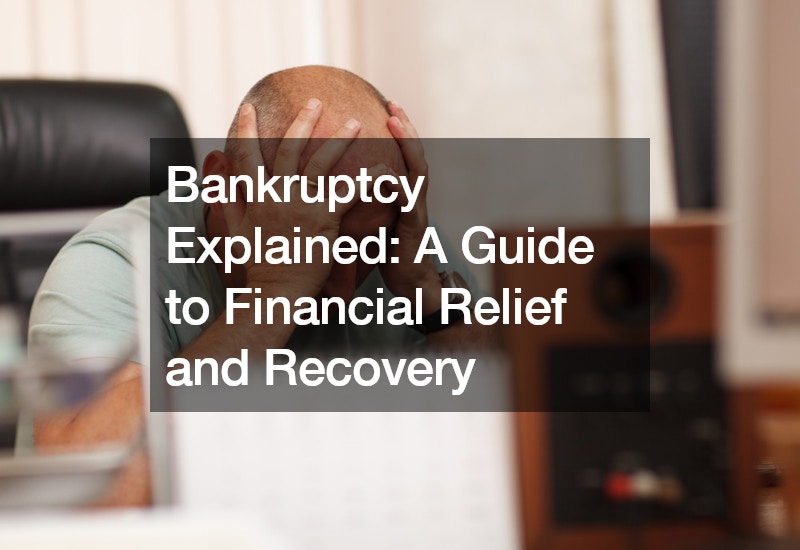Debt can feel like a suffocating weight, and when the burden becomes insurmountable, bankruptcy may seem like the only escape route. Often portrayed as a financial doomsday, bankruptcy is actually a legal process designed to offer relief and a path towards rebuilding your financial health. This guide explores the different types of bankruptcy, their consequences, and alternative solutions to consider before taking this step.
Understanding Insolvency
The foundation of bankruptcy lies in the concept of insolvency – the inability to meet your financial obligations as they come due. This can stem from various situations: overspending, job loss, medical emergencies, or even unexpected life events.
When faced with insolvency, creditors (those you owe money to) can resort to lawsuits, wage garnishments, and relentless collection calls, creating immense stress and hardship.
Bankruptcy: A Fresh Start, Not a Free Pass
Bankruptcy offers a lifeline in these circumstances. It’s a court-supervised process that discharges (eliminates) or restructures your debts, providing much-needed breathing room. However, it’s important to dispel the myth of bankruptcy as a magic solution. It comes with consequences that need careful consideration.
Types of Bankruptcy: Chapter 7 and Chapter 13
There are two primary types of bankruptcy for individuals in the United States: Chapter 7 and Chapter 13. Each offers a different approach to resolving debt:
- Chapter 7: Liquidation Bankruptcy
Often referred to as “straight bankruptcy,” Chapter 7 involves selling your non-exempt assets (those not protected by law) to repay creditors. A court-appointed trustee oversees the process, ensuring a fair distribution of proceeds. While some assets like essential household items and clothing are exempt, others like cars or investment accounts might be sold. Consulting with a bankruptcy attorney is crucial to understand which assets are exempt and how the process unfolds. - Chapter 13: Repayment Plan
Chapter 13 allows you to keep your assets by creating a court-approved repayment plan over 3-5 years. During this period, you make monthly payments to a trustee who then distributes the funds to your creditors. This option is suitable for individuals with a steady income who want to avoid asset liquidation but can commit to a structured repayment plan.
Eligibility and Considerations
Eligibility for Chapter 7 bankruptcy is determined by a means test, which assesses your income and expenses to determine your ability to repay debts. A bankruptcy attorney can guide you through the means test process and advise you on whether Chapter 7 is the best option for your situation.
Consequences of Bankruptcy
While bankruptcy offers relief, it’s not without its repercussions. Here are some key points to consider:
- Impact on Credit Score: Bankruptcy can significantly damage your credit score for up to 7-10 years, making it difficult to obtain loans or credit cards with favorable terms.
- Employment Implications: Though less common, some employers might consider your credit history during the hiring process.
- Limitations on Future Filings: Subsequent bankruptcy filings are subject to stricter regulations, making it harder to obtain relief again in the short term.
Alternatives to Bankruptcy: Exploring Options
Before considering bankruptcy, it’s vital to explore alternative solutions that may help manage your debt:
- Credit Counseling: Non-profit credit counseling agencies can assist you in creating a debt management plan, negotiating with creditors to lower interest rates, and developing budgeting skills to get your finances back on track.
- Debt Consolidation Loan: This option involves taking a single loan with a lower interest rate to pay off multiple high-interest debts, simplifying your repayment process and potentially reducing overall costs.
- Debt Settlement: A debt settlement company negotiates with creditors to settle your debts for less than the full amount owed. However, this route can further damage your credit score and involve upfront fees.
Consulting with a bankruptcy attorney can help you assess your situation and determine which option aligns best with your financial goals.
The Road to Recovery
Regardless of the path you choose, a vital component of overcoming debt is building healthy financial habits. This includes:
- Creating a Budget: Track your income and expenses to understand your spending patterns and identify areas for reduction.
- Prioritizing Debt Repayment: Develop a strategy to prioritize the repayment of high-interest debts first.
- Building Emergency Savings: Aim to accumulate an emergency fund to cover unexpected expenses and prevent future debt accumulation.
Bankruptcy can be a valuable tool for those struggling with overwhelming debt. By understanding the types of bankruptcy, the consequences involved, and exploring alternative solutions, you can make informed decisions about your financial future. Remember, filing for bankruptcy is a legal process, and consulting with a bankruptcy attorney throughout the journey is highly recommended. With the right guidance and a commitment to responsible financial management, you can navigate through this challenging period and emerge on a stronger financial footing.
.

